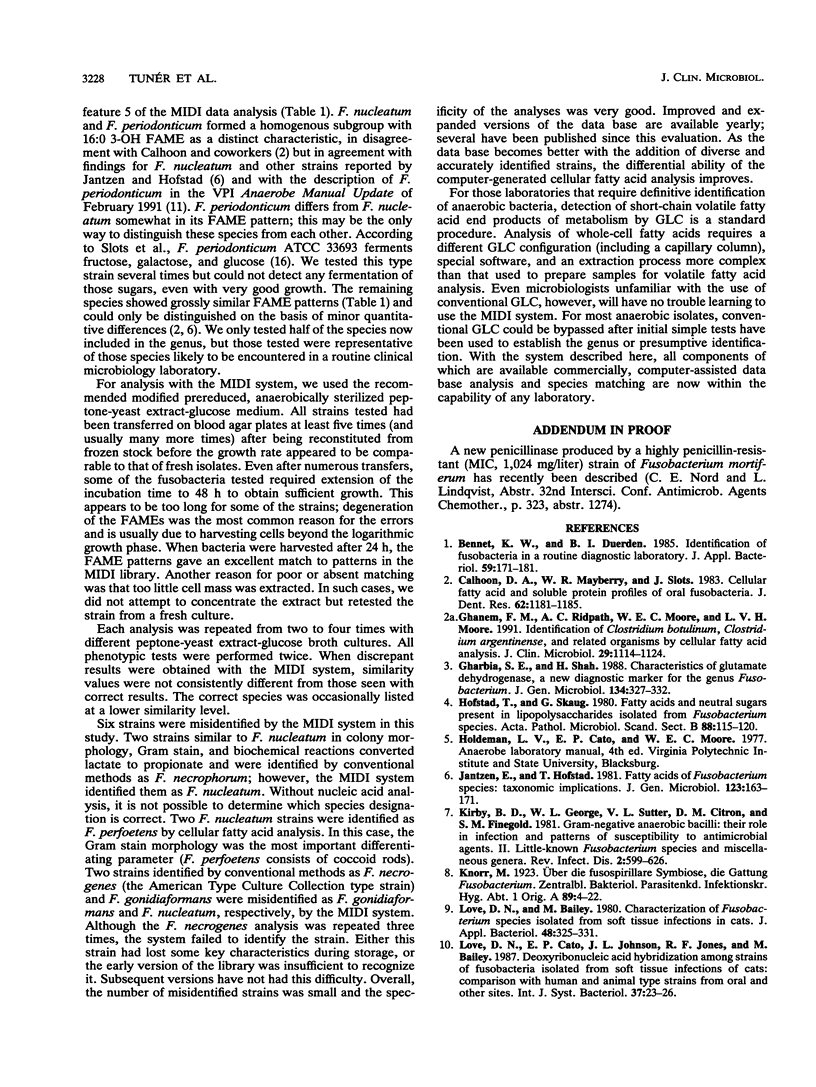Abstract
Identification of fusobacteria from clinical specimens currently requires analysis of metabolic end products by gas-liquid chromatography in addition to certain biochemical and enzymatic tests because of the relative biochemical inactivity of these bacteria. Even the finding of pointed, thin gram-negative cells on Gram-stained slides can no longer be relied on for identification of Fusobacterium nucleatum, since at least four other species of fusobacteria have been seen to exhibit similar morphology. We examined 46 clinical isolates and six American Type Culture Collection type strains of fusobacteria by conventional methods and by the Microbial ID Systems MIDI software package for analyzing cellular fatty acid patterns measured by capillary column gas-liquid chromatography. Distinctive patterns of major fatty acids could be used to reliably identify most clinical isolates to the species level. The MIDI system identified 89% of the isolates correctly and provides an alternative to conventional methods.
Full text
PDF




Selected References
These references are in PubMed. This may not be the complete list of references from this article.
- Bennett K. W., Duerden B. I. Identification of fusobacteria in a routine diagnostic laboratory. J Appl Bacteriol. 1985 Aug;59(2):171–181. doi: 10.1111/j.1365-2672.1985.tb03318.x. [DOI] [PubMed] [Google Scholar]
- Calhoon D. A., Mayberry W. R., Slots J. Cellular fatty acid and soluble protein profiles of oral fusobacteria. J Dent Res. 1983 Dec;62(12):1181–1185. doi: 10.1177/00220345830620120101. [DOI] [PubMed] [Google Scholar]
- George W. L., Kirby B. D., Sutter V. L., Citron D. M., Finegold S. M. Gram-negative anaerobic bacilli: Their role in infection and patterns of susceptibility to antimicrobial agents. II. Little-known Fusobacterium species and miscellaneous genera. Rev Infect Dis. 1981 May-Jun;3(3):599–626. doi: 10.1093/clinids/3.3.599. [DOI] [PubMed] [Google Scholar]
- Ghanem F. M., Ridpath A. C., Moore W. E., Moore L. V. Identification of Clostridium botulinum, Clostridium argentinense, and related organisms by cellular fatty acid analysis. J Clin Microbiol. 1991 Jun;29(6):1114–1124. doi: 10.1128/jcm.29.6.1114-1124.1991. [DOI] [PMC free article] [PubMed] [Google Scholar]
- Gharbia S. E., Shah H. N. Characteristics of glutamate dehydrogenase, a new diagnostic marker for the genus Fusobacterium. J Gen Microbiol. 1988 Feb;134(2):327–332. doi: 10.1099/00221287-134-2-327. [DOI] [PubMed] [Google Scholar]
- Hofstad T., Skaug N. Fatty acids and neutral sugars present in lipopolysaccharides isolated from Fusobacterium species. Acta Pathol Microbiol Scand B. 1980 Apr;88(2):115–120. doi: 10.1111/j.1699-0463.1980.tb02615.x. [DOI] [PubMed] [Google Scholar]
- Jantzen E., Hofstad T. Fatty acids of Fusobacterium species: taxonomic implications. J Gen Microbiol. 1981 Mar;123(1):163–171. doi: 10.1099/00221287-123-1-163. [DOI] [PubMed] [Google Scholar]
- Love D. N., Jones R. F., Bailey M. Characterization of Fusobacterium species isolated from soft tissue infections in cats. J Appl Bacteriol. 1980 Apr;48(2):325–331. doi: 10.1111/j.1365-2672.1980.tb01232.x. [DOI] [PubMed] [Google Scholar]
- Morgenstein A. A., Citron D. M., Finegold S. M. New medium selective for Fusobacterium species and differential for Fusobacterium necrophorum. J Clin Microbiol. 1981 Apr;13(4):666–669. doi: 10.1128/jcm.13.4.666-669.1981. [DOI] [PMC free article] [PubMed] [Google Scholar]
- Potts T. V., Holdeman L. V., Slots J. Relationships among the oral fusobacteria assessed by DNA-DNA hybridization. J Dent Res. 1983 Jun;62(6):702–705. doi: 10.1177/00220345830620060101. [DOI] [PubMed] [Google Scholar]
- Shinjo T., Hiraiwa K., Miyazato S. Recognition of biovar C of Fusobacterium necrophorum (Flügge) Moore and Holdeman as Fusobacterium pseudonecrophorum sp. nov., nom. rev. (ex Prévot 1940). Int J Syst Bacteriol. 1990 Jan;40(1):71–73. doi: 10.1099/00207713-40-1-71. [DOI] [PubMed] [Google Scholar]
- Slots J., Potts T. V., Mashimo P. A. Fusobacterium periodonticum, a new species from the human oral cavity. J Dent Res. 1983 Sep;62(9):960–963. doi: 10.1177/00220345830620090901. [DOI] [PubMed] [Google Scholar]
- Tunér K., Lindqvist L., Nord C. E. Characterization of a new beta-lactamase from Fusobacterium nucleatum by substrate profiles and chromatofocusing patterns. J Antimicrob Chemother. 1985 Jul;16(1):23–30. doi: 10.1093/jac/16.1.23. [DOI] [PubMed] [Google Scholar]


